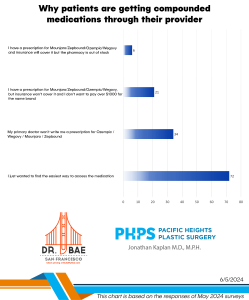
One of the reasons I’ve built a worldview that includes price transparency is because I recognized early on that everyone wants to know cost ahead of time. So why make it difficult for them. No one likes sticker shock. But there’s another benefit of price transparency.
By knowing the cost ahead of time, the hope is the patient will feel less of an urge to ask for a discount or a special. In other words, “this is the price, be prepared when you come in.” However, as we all know, it doesn’t always work out that way. In this Amazon world, discounts and specials are just a way of life. If left unchecked, discounting and specials can lead to a race to the bottom where everyone is undercutting their competitors. This potentially leads to the cheapening of a brand.
Which is why bargaining, an even more insidious cousin of discounting and promotions, takes things a bit too far. If you have to choose between the two, discounts vs bargaining, discounting is the lesser evil. If we embrace discounts and promotions in certain circumstances using certain techniques, we can “build a fence” around the potential for bargaining so that it never gets to that point.
Bargaining in a bazaar may be in the natural order of things in that setting, but it has no role in healthcare. Even for medically unnecessary aesthetic procedures.
How to use discounts and specials the “right” way
Having a set program or programs to allow for discounting can be an effective way to draw patients in. And at the same time, avoid cheapening the brand.
In our practice, we offer discounts and specials in three different formats. While they all provide a discount to the patient, there’s an equally important benefit to the practice, in addition to greater patient volume. In each format description below, take special note of the additional benefits that show how discounting and specials can serve a greater purpose.
Online purchases
On our website, we allow patients to purchase non-surgical services (neuromodulators like BOTOX®/Xeomin and fillers) and skin care products online. And when these purchases are made online, a nominal discount is included.
Even before we realized the benefits of contactless payments during the pandemic, online purchasing is just plain more convenient. Convenient for the patient and the practice. Consider a patient that purchases skin care online. Tax, shipping and a discount are already included. This saves the patient from having to come in unnecessarily but it also encourages the patient to continue taking the path of least resistance. Why seek out another practice when the patient can get the products (or prescription creams) they want delivered to their door with just a few clicks!
For injectables like Botox or fillers, the patient of course still needs to come in for treatment. But similar to buying a movie ticket online, there’s no need to stop at the front desk/ticket booth to make a payment. The transaction already occured online. More importantly, there’s the added benefit of privacy for the patients by not having to check out on the way out the door.
On an equally practical note, how do practices that run specials keep up with all of the deals swirling around all the time? Have you ever sent out or received an email from an aesthetic physician’s office? There’s a ton of specials listed! How does the front office staff track the current specials and not accidentally discount the wrong item for the wrong amount? With online-only discounts, they’ll always pay the correct amount. In our practice, whenever a patient purchases online, a voucher is automatically generated that clarifies the amount paid and the amount of product or Injectible they’re eligible to redeem.
We’re fans of online purchasing. Here are some of the benefits:
- contactless payments
- enhance privacy by avoiding front desk checkout
- reduce lost revenue from inaccurate discounting
Subscriptions and Memberships
This specials format includes recurring payments that either cover the entire cost of the service in question (subscriptions) or give the consumer access to additional discounts in the future (memberships).
For subscriptions, payments are structured so that a monthly payment covers the entire cost of a discounted quarterly treatment, such as Botox. Therefore, when the patient comes in for their treatment every three months, they pay nothing out of pocket during that visit. Psychologically, if the patient feels like the treatment cost nothing at the time of their office visit, they’re open to purchasing another service. Thus leading to greater, unexpected revenue.
Memberships involve lower monthly payments that don’t cover the cost of any service. But they do offer the availability of VIP (discounted) services. Similar to subscriptions, patients may rationalize additional purchases because of the savings.
While a one-time online purchase described above has the benefit of capturing the patient, it doesn’t incur loyalty the way subscriptions and memberships do. With recurring payments and repeat traffic, this is the easiest way to build a long-term patient-doctor relationship.
Consider subscriptions and memberships to realize these benefits:
- loyalty
- recurring revenue
- increased revenue from the purchase of non-subscription items while in the office
Day of consult discounts
Consider this scenario that takes place in most offices: A patient puts down a deposit to hold their place for a larger procedure. Then, 2-3 weeks prior to the procedure, the balance is due. Capturing the balance is never as easy as one would hope.
Often times, the office staff must go to great lengths to track down the patient to collect those remaining funds. Multiple phone calls, patients not calling back, endless games. And even if it doesn’t require multiple phone calls, it still requires at least one, potentially avoidable phone call.
Why do physicians’ practices put themselves in this time-consuming position? Wasting so many hours following up with the patient, trying to collect prior to the procedure? Not to mention the angst of wondering if the patient can pay the balance in advance of the operation. Or the frustration of postponing the procedure because they can’t. Which in turn leads to awkward conversations, hurt feelings, miscommunication and potentially a bad online review.
Wouldn’t it be great if the patient would book and pay in full at the time of the consultation? That would have the benefit of less wasted time trying to track down the patient and your office staff wouldn’t feel like a bounty hunter! With the right incentive, it’s possible.
At the time the patient schedules the consultation over the phone, we let them know the probable cost of their procedure. This is based on the information they provide regarding their concerns. We let them know that if they come in prepared to pay that amount in full at the time of consultation, they’ll receive a discount ($1000 for a procedure greater than $10,000 or $500 for a procedure less than $10,000).
This discount is a great benefit for the patient but clearly, there’s also a huge benefit to the practice. We gain increased productivity not chasing patients for the balance of their procedure. With a combination of price transparency prior to the consultation and incentivizing the patient with a discount, 72% of patients that booked surgery at the time of their consult paid in full, including procedures costing $22,000!
Benefit to the practice:
- improved cash flow with full payment up front
- incentivize only the most serious patients to come in for consultation
- avoid wasted time on tracking down patients for the remainder of their balance
Summary
Bottom line, don’t discount without a purpose! By linking discounts and specials to specific goals, other benefits will reveal themselves. These include 1) improving cash flow, 2) incurring loyalty, 3) increasing productivity (reducing time wasted), 4) avoiding confusion in regards to which specials are being offered and 5) having enough hard-wired options for discounting that a reasonable patient knows the practice’s disposition on price, and never has the opportunity or urge to resort to bargaining.
Let your competitors race to the bottom while you stay above the fray!
Click here for the original blog post written by Dr. Kaplan for BuildMyBod.




